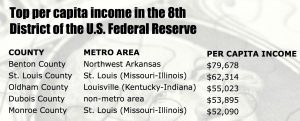Benton County tops Fed’s 8th District income, Lincoln County near bottom
by April 2, 2018 12:41 pm 721 views

A new report from the St. Louis Federal Reserve shows paychecks for workers in Benton County have the highest purchasing power in the nation’s expansive Eighth District, while real per capita personal income in rural Lincoln County in the Arkansas Delta ranks near the bottom.
The report, “Income and Living Standards with the Eighth District,” uses the Bureau of Economic Analysis’ regional price parity (RPP) indexes from 2015 to measure living standards across the Federal Reserve district that includes 338 counties in all of Arkansas and portions of Illinois, Indiana, Kentucky, Mississippi, Missouri and Tennessee.
Under the RPP model by state, metropolitan statistical area or nonmetropolitan area, RPPs are constructed to compare prices relative to the national average. For example, the RPP for the U.S. is 100, which would put the cost of living standard in each of the counties in the seven-state district is below the national average.
In the report, economic researchers at the Federal Reserve Bank of St. Louis note that the average RPP for the Eighth District is 86.6, suggesting that the cost of living across the region is about 15% below the national average.
Benton County, which is part of the Fayetteville-Springdale and Rogers MSA, has a RPP rating of 89.8, which will give each worker an adjusted real per capita income of $79,678. St. Louis County, which straddles the Illinois-Missouri economy surrounding the city of St. Louis, was ranked second with a RPP score of 90.6, adjusting the region’s per capita personal income to $62,314.
Oldham County near Louisville, Ky., Dubois County in Indiana and suburban Monroe County in the St. Louis area were the MSAs ranked in the top five with RPP-adjusted per capita personal income of $55,023, $53,895 and $52,090, respectively.
OUTLIERS
Calling Benton and St. Louis counties “outliers,” Fed economists Brain Reinbold and Yi Wen note although there is income inequality, the standard of living gap between the district and the rest of the nation has shrunk dramatically from $13,000 to $7,500 in recent years. The average 2015 RPP-adjusted real per capita personal income for Eighth District counties within MSAs or urban areas is $38,735, while the average for District counties outside of MSAs is $35,689.
 “The ‘richest’ county commands a living standard more than 300% of that in the “poorest” county,” writes Reinbold and Wen. “For example, the living standard in St. Louis County, Missouri is $62,314, and the living standard in Benton County, Arkansas, is $79,678. Still, despite these outliers, living standard is relatively consistent across most counties in the District.”
“The ‘richest’ county commands a living standard more than 300% of that in the “poorest” county,” writes Reinbold and Wen. “For example, the living standard in St. Louis County, Missouri is $62,314, and the living standard in Benton County, Arkansas, is $79,678. Still, despite these outliers, living standard is relatively consistent across most counties in the District.”
On the other end of the scale, Lincoln County in the Arkansas Delta region ranks among the 338 counties across the district with the lowest RPP ratings at 83.5 and adjusted real capita personal income of only $26,483. That county includes parts of the Pine Bluff metro area. The rural timberland and agriculture region also has the Arkansas Department of Correction’s Cummins and Varner prison units as the county’s major employer.
Three other rural areas – Douglas County in Missouri, Lake County in Tennessee and Shannon County in Missouri – had the lowest adjusted real capita income at $25,771, $26,068 and $26,089, respectively. Benton County in Mississippi, which abuts the Tennessee, Mississippi and Arkansas borders in the Memphis MSA, rounded out the bottom five with RPP-adjusted per capita personal income of $27,641.
According to Reinbold and Wen, adjusting income for cost of living allows the St. Louis Fed to evaluate inequality in income in regards to local purchasing power.
“In other words, the purchasing power of a dollar is not the same across regions due to variations in the cost of living. Therefore, factoring in cost of living can yield fruitful insights about true inequality,” stated the Fed economists.
Reinbold and Wen’s report also notes that the cost of living is not even across the region. For example, the MSA with the lowest RPP is Jonesboro at 81.9, while Columbia, Mo., has the highest RPP at 92.2.
“Nonmetropolitan, or more rural, areas tend to have lower RPPs and thus a lower cost of living,” the Fed economists note. “We see that overall inequality is not so severe in the District once adjusted for the cost of living, both across counties and in comparison to the nation. We also see that living standards tend to be higher within MSAs than outside them.”
In recent events across the U.S., St. Louis Fed President James Bullard has demonstrated the importance of adjusting income for cost of living across MSAs in the U.S. On Wednesday, Bullard will speak at the Arkansas Bankers Association & Arkansas State Bank Department’s Day with the Commissioner in Little Rock. The St. Louis Fed chief oversees one of the 12 Federal Reserve Banks that set the nation’s monetary policy and supervise and examine members banks across the U.S.
